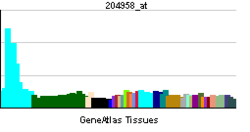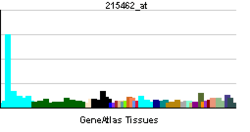PLK3
| View/Edit Human | View/Edit Mouse |
Polo-like kinase 3 (Drosophila), also known as PLK3, is an enzyme which in humans is encoded by the PLK3 gene.[3][4]
Function
Cytokine-inducible kinase is a putative serine/threonine kinase. CNK contains both a catalytic domain and a putative regulatory domain. It may play a role in regulation of cell cycle progression and tumorigenesis.[3]
Interactions
PLK3 has been shown to interact with:
References
- ↑ "Human PubMed Reference:".
- ↑ "Mouse PubMed Reference:".
- 1 2 "Entrez Gene: PLK3 polo-like kinase 3 (Drosophila)".
- ↑ Li B, Ouyang B, Pan H, Reissmann PT, Slamon DJ, Arceci R, Lu L, Dai W (August 1996). "Prk, a cytokine-inducible human protein serine/threonine kinase whose expression appears to be down-regulated in lung carcinomas". J. Biol. Chem. 271 (32): 19402–8. doi:10.1074/jbc.271.32.19402. PMID 8702627.
- ↑ Ouyang B, Li W, Pan H, Meadows J, Hoffmann I, Dai W (Oct 1999). "The physical association and phosphorylation of Cdc25C protein phosphatase by Prk". Oncogene. 18 (44): 6029–36. doi:10.1038/sj.onc.1202983. PMID 10557092.
- 1 2 Bahassi el M, Conn CW, Myer DL, Hennigan RF, McGowan CH, Sanchez Y, Stambrook PJ (Sep 2002). "Mammalian Polo-like kinase 3 (Plk3) is a multifunctional protein involved in stress response pathways". Oncogene. 21 (43): 6633–40. doi:10.1038/sj.onc.1205850. PMID 12242661.
- ↑ Xie S, Wu H, Wang Q, Cogswell JP, Husain I, Conn C, Stambrook P, Jhanwar-Uniyal M, Dai W (Nov 2001). "Plk3 functionally links DNA damage to cell cycle arrest and apoptosis at least in part via the p53 pathway". J. Biol. Chem. 276 (46): 43305–12. doi:10.1074/jbc.M106050200. PMID 11551930.
Further reading
- Li B, Ouyang B, Pan H, Reissmann PT, Slamon DJ, Arceci R, Lu L, Dai W (1996). "Prk, a cytokine-inducible human protein serine/threonine kinase whose expression appears to be down-regulated in lung carcinomas". J. Biol. Chem. 271 (32): 19402–8. doi:10.1074/jbc.271.32.19402. PMID 8702627.
- Peng CY, Graves PR, Thoma RS, Wu Z, Shaw AS, Piwnica-Worms H (1997). "Mitotic and G2 checkpoint control: regulation of 14-3-3 protein binding by phosphorylation of Cdc25C on serine-216". Science. 277 (5331): 1501–5. doi:10.1126/science.277.5331.1501. PMID 9278512.
- Ouyang B, Pan H, Lu L, Li J, Stambrook P, Li B, Dai W (1997). "Human Prk is a conserved protein serine/threonine kinase involved in regulating M phase functions". J. Biol. Chem. 272 (45): 28646–51. doi:10.1074/jbc.272.45.28646. PMID 9353331.
- Kauselmann G, Weiler M, Wulff P, Jessberger S, Konietzko U, Scafidi J, Staubli U, Bereiter-Hahn J, Strebhardt K, Kuhl D (1999). "The polo-like protein kinases Fnk and Snk associate with a Ca(2+)- and integrin-binding protein and are regulated dynamically with synaptic plasticity". EMBO J. 18 (20): 5528–39. doi:10.1093/emboj/18.20.5528. PMC 1171621
 . PMID 10523297.
. PMID 10523297. - Ouyang B, Li W, Pan H, Meadows J, Hoffmann I, Dai W (1999). "The physical association and phosphorylation of Cdc25C protein phosphatase by Prk". Oncogene. 18 (44): 6029–36. doi:10.1038/sj.onc.1202983. PMID 10557092.
- Shieh SY, Ahn J, Tamai K, Taya Y, Prives C (2000). "The human homologs of checkpoint kinases Chk1 and Cds1 (Chk2) phosphorylate p53 at multiple DNA damage-inducible sites". Genes Dev. 14 (3): 289–300. PMC 316358
 . PMID 10673501.
. PMID 10673501. - Dai W, Li Y, Ouyang B, Pan H, Reissmann P, Li J, Wiest J, Stambrook P, Gluckman JL, Noffsinger A, Bejarano P (2000). "PRK, a cell cycle gene localized to 8p21, is downregulated in head and neck cancer". Genes Chromosomes Cancer. 27 (3): 332–6. doi:10.1002/(SICI)1098-2264(200003)27:3<332::AID-GCC15>3.0.CO;2-K. PMID 10679924.
- Matsuoka S, Rotman G, Ogawa A, Shiloh Y, Tamai K, Elledge SJ (2000). "Ataxia telangiectasia-mutated phosphorylates Chk2 in vivo and in vitro". Proc. Natl. Acad. Sci. U.S.A. 97 (19): 10389–94. doi:10.1073/pnas.190030497. PMC 27034
 . PMID 10973490.
. PMID 10973490. - Holtrich U, Wolf G, Yuan J, Bereiter-Hahn J, Karn T, Weiler M, Kauselmann G, Rehli M, Andreesen R, Kaufmann M, Kuhl D, Strebhardt K (2000). "Adhesion induced expression of the serine/threonine kinase Fnk in human macrophages". Oncogene. 19 (42): 4832–9. doi:10.1038/sj.onc.1203845. PMID 11039900.
- Bulavin DV, Higashimoto Y, Popoff IJ, Gaarde WA, Basrur V, Potapova O, Appella E, Fornace AJ (2001). "Initiation of a G2/M checkpoint after ultraviolet radiation requires p38 kinase". Nature. 411 (6833): 102–7. doi:10.1038/35075107. PMID 11333986.
- Xie S, Wu H, Wang Q, Cogswell JP, Husain I, Conn C, Stambrook P, Jhanwar-Uniyal M, Dai W (2001). "Plk3 functionally links DNA damage to cell cycle arrest and apoptosis at least in part via the p53 pathway". J. Biol. Chem. 276 (46): 43305–12. doi:10.1074/jbc.M106050200. PMID 11551930.
- Latonen L, Taya Y, Laiho M (2001). "UV-radiation induces dose-dependent regulation of p53 response and modulates p53-HDM2 interaction in human fibroblasts". Oncogene. 20 (46): 6784–93. doi:10.1038/sj.onc.1204883. PMID 11709713.
- Ahn JY, Li X, Davis HL, Canman CE (2002). "Phosphorylation of threonine 68 promotes oligomerization and autophosphorylation of the Chk2 protein kinase via the forkhead-associated domain". J. Biol. Chem. 277 (22): 19389–95. doi:10.1074/jbc.M200822200. PMID 11901158.
- Sumara I, Vorlaufer E, Stukenberg PT, Kelm O, Redemann N, Nigg EA, Peters JM (2002). "The dissociation of cohesin from chromosomes in prophase is regulated by Polo-like kinase". Mol. Cell. 9 (3): 515–25. doi:10.1016/S1097-2765(02)00473-2. PMID 11931760.
- Wang Q, Xie S, Chen J, Fukasawa K, Naik U, Traganos F, Darzynkiewicz Z, Jhanwar-Uniyal M, Dai W (2002). "Cell cycle arrest and apoptosis induced by human Polo-like kinase 3 is mediated through perturbation of microtubule integrity". Mol. Cell. Biol. 22 (10): 3450–9. doi:10.1128/MCB.22.10.3450-3459.2002. PMC 133784
 . PMID 11971976.
. PMID 11971976. - Bahassi el M, Conn CW, Myer DL, Hennigan RF, McGowan CH, Sanchez Y, Stambrook PJ (2002). "Mammalian Polo-like kinase 3 (Plk3) is a multifunctional protein involved in stress response pathways". Oncogene. 21 (43): 6633–40. doi:10.1038/sj.onc.1205850. PMID 12242661.
- Tsvetkov L, Xu X, Li J, Stern DF (2003). "Polo-like kinase 1 and Chk2 interact and co-localize to centrosomes and the midbody". J. Biol. Chem. 278 (10): 8468–75. doi:10.1074/jbc.M211202200. PMID 12493754.
- Xie S, Wu H, Wang Q, Kunicki J, Thomas RO, Hollingsworth RE, Cogswell J, Dai W (2003). "Genotoxic stress-induced activation of Plk3 is partly mediated by Chk2". Cell Cycle. 1 (6): 424–9. doi:10.4161/cc.1.6.271. PMID 12548019.
- Bahassi el M, Hennigan RF, Myer DL, Stambrook PJ (2004). "Cdc25C phosphorylation on serine 191 by Plk3 promotes its nuclear translocation". Oncogene. 23 (15): 2658–63. doi:10.1038/sj.onc.1207425. PMID 14968113.
This article is issued from Wikipedia - version of the 5/20/2016. The text is available under the Creative Commons Attribution/Share Alike but additional terms may apply for the media files.

